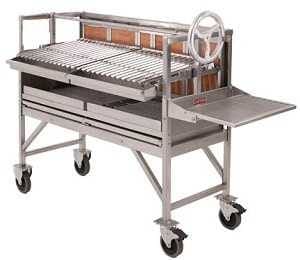YOU ARE HERE >> AmazingRibs » Ratings & Reviews » Grillworks 42 Asador Review
Grillworks 42 Asador Review
All of our reviews are done independently by our team of testers and are in no way influenced by advertising or other monetary compensation from manufacturers. Click here to learn more about our unbiased product review process.
Published On: 3/22/2013 Last Modified: 1/16/2025

The Grillworks 42 Asador has two 21″ x 19″ adjustable height grates. Asadors are Grillworks most popular models with a floating firebrick wall that lines the back with removable, replaceable refractory fire bricks. The bricks retain and reflect heat while providing protection to outer surfaces. These grills are heavy, requiring a 304 stainless inner tube frame and four, heavy duty, locking casters.
Grillworks Wood Fired Artisanal Grills cook over an open wood fire using a crank to raise or lower the grates for heat control. Widely used in Spain, Italy and South America, this type of grill was popularized in the United States in Southern California and commonly referred to as Santa Maria after the namesake town northwest of Los Angeles. There are many variations on the basic vertical lift design. Grillworks DNA comes from Argentina, where they are called parrilla grills. A unique feature of many parrilla grills is the grates: V-shaped metal channels pitched at a slight downward angle toward the cook. These channels collect and divert meat juices from the fire to reduce flare-ups. Grillworks also employs long, detachable catch pans that hang across the front to accumulate tasty drippings from the V-grates.
Grates and frames are heavy duty 304 stainless steel. Frames may be upgraded to 316 marine grade stainless for use around salt water. 316 stainless is resistant to salt water discoloration. A crank axel runs across the top. Argentine V-grates are affixed to a lift frame and suspended from the axel with metal cables. A large cast aluminum crank wheel is used to wind the cable up or down and position the grates at the desired relationship to the fire. Grates are said to fit most dishwashers.
Removable catch pans hook onto mounts at the front of the lift frame. Wood is placed in fire grates that occupy a lower shelf. Underneath is a shallow, slide-out ash tray. A “Persuader” tools come with each grill: a single, metal V on a long handle used to persuade drippings down the V channels into the basting pans. Could a row of these V-shaped metal pieces be more efficient?
No models are offered with a hood so this truly is open fire cooking. With nothing enclosed, cooks have easy access to food and fire. There are no dampers, simply tend the wood fire and raise and lower the grates as needed. Of course charcoal may be used, but why? The process for manufacturing charcoal intentionally removes volatile organic compounds that impart the sensational BBQ flavor we crave. Allowed to burn hot, wood easily produces clean light smoke: the kind of smoke Texas pit bosses labor to create while maintaining their low and slow fires.
You may start cooking as soon as a steady fire is established and use the adjustable height grate to hit the desired heat. Avoid softwoods, like pine, fir, spruce, redwood, hemlock, and cypress. All are evergreens (coniferous trees), and have more air, more pungent sap, and burn fast. Go with hardwoods like hickory and apple. Grillworks recommends experimenting with flavors of different woods and pairing them with your creations as you would seasoning or wine.
Aficionados of Argentine grates like to add spices, oils and wines to the catch pans to mix with drippings for basting and/or making sauces. Diverting the drippings from the fire is said to reduce flare-ups and allow cooks to lower meats very close to the flame for powerful searing: perfect for thin foods like steak, but somewhat challenging for larger roasts because there is no lid. Grillworks recommends resting larger meats, like a turkey, on a bed of fresh herbs over a moderate fire. We expect one needs to turn roasts periodically on any vertical lift style grill. The optional rotisserie is also an asset with this design.
Air is pulled from the front, under the grates by oxygen hungry flames and exits upward from the back creating heat zones on the cooking surface: cool front, medium middle and hot back. Eisendrath estimates temperature range at medium heat configurations as 150 to 200F/front, 300 to 500F/middle and 600 to 700F/back. Set for hot cooking, he estimates 200F/front, 400 to 500F/middle and 900F/back. In addition to durability and low maintenance, stainless steel provides an added benefit for Grillworks grates because it heats up and cools down faster than cast iron when raised or lowered.
Click the buttons below to search our complete database of reviews:
Product Information:
-
Model:42 Asador
-
Item Price :6,850.00
*Price Subject To Change -
Made in USA:yes
-
Review Method:Researched it from Afar
We have researched this product from afar by gathering info from the manufacturer, owners, and other reliable sources, with our BS meters on high. -
Primary Function:Grill
-
Fuel:Charcoal, Logs
-
Primary Capacity:
